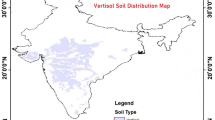Abstract
The knowledge of the unsaturated hydraulic conductivity (K) is very essential for the various fields of water resources, irrigation, and hydrology. It is also important to know the phenomena of water movement on the ground constantly. In order to better forecast unsaturated hydraulic conductivity, this article reports the comparison of efficacy of five distinct soft computing approaches: support vector machine (SVM), random forest, Gaussian process (GP), gene expression techniques, and multivariate adaptive regression spline. Three kernels function (Poly, RBF, and PUK) were used in SVM and GP modeling techniques. For fulfill this aim, experimentation has been performed using mini-disc infiltrometer in 20 locations in Ghaggar basin. Total 240 observations were collected, and out of which, 70% were used for training the model and remaining for testing. The input variables of this investigation were sand, clay, silt, bulk density (ρ) and moisture content and output variable was K. The result of modeling techniques suggests that PUK kernel with SVM was superior to the other modeling techniques. This implies that these computational methods can be used to make estimates about the values of K at any time.















Similar content being viewed by others
Data availability
The datasets generated during the current study are available from the corresponding author on reasonable request.
References
Agyare WA, Park SJ, Vlek PLG (2007) Artificial neural network estimation of saturated hydraulic conductivity. Vadose Zone J 6(2):423–431
Arshad RR, Sayyad G, Mosaddeghi M, Gharabaghi B (2013) Predicting saturated hydraulic conductivity by artificial intelligence and regression models. ISRN Soil Sci 2013:1–8
Breiman LF, Friedman JH, Olshen S, Stone C (1983) Classification and regression trees. Pacific Grove, Kalifornien
Das SK, Samui P, Sabat AK (2012) Prediction of field hydraulic conductivity of clay liners using an artificial neural network and support vector machine. Int J Geomech 12(5):606–611
Elbisy MS (2015) Support vector machine and regression analysis to predict the field hydraulic conductivity of sandy soil. KSCE J Civ Eng 19(7):2307–2316
Elith J, Leathwick JR, Hastie T (2008) A working guide to boosted regression trees. J Anim Ecol 77(4):802–813
Erzin Y, Gumaste SD, Gupta AK, Singh DN (2009) Artificial neural network (ANN) models for determining hydraulic conductivity of compacted fine-grained soils. Can Geotech J 46(8):955–968
Ferreira C (2002) Gene expression programming in problem solving. In: Soft computing and industry, pp 635–653
Ferreira C (2006) Gene expression programming: mathematical modeling by an artificial intelligence 21
Friedman JH (1991) Multivariate adaptive regression splines. Ann Stat 19(1):1–67
Kuss M (2006) Gaussian process models for robust regression, classification, and reinforcement learning (Doctoral dissertation, Ph.D. thesis, Technische Universität, Darmstadt), p 189. http://tuprints.ulb.tu-darmstadt.de/id/eprint/674
Parsaie A, Haghiabi A (2015) The effect of predicting discharge coefficient by neural network on increasing the numerical modeling accuracy of flow over side weir. Water Resour Manag 29:973–985
Rasmussen CE, Williams CK (2006) Gaussian processes for machine learning, vol 1. MIT Press, Cambridge, p 248
Rogiers B, Mallants D, Batelaan O, Gedeon M, Huysmans M, Dassargues A (2012) Estimation of hydraulic conductivity and its uncertainty from grain-size data using GLUE and artificial neural networks. Math Geosci 44(6):739–763. https://doi.org/10.1007/s11004-012-9409-2
Safari MJ (2020) Hybridization of multivariate adaptive regression splines and random forest models with an empirical equation for sediment deposition prediction in open channel flow. J Hydrol 1(590):125392
Samui P (2013) Multivariate adaptive regression spline (Mars) for prediction of elastic modulus of jointed rock mass. Geotech Geol Eng 31(1):249–253
Shiri J (2017) Evaluation of FAO56-PM, empirical, semi-empirical and gene expression programming approaches for estimating daily reference evapotranspiration in hyper-arid regions of Iran. Agric Water Manag 188:101–114. https://doi.org/10.1016/j.agwat.2017.04.009
Sihag P, Jain P, Kumar M (2018) Modelling of impact of water quality on recharging rate of storm water filter system using various kernel function based regression. Model Earth Syst Environ 4:61–68
Sihag P, Tiwari NK, Ranjan S (2017) Estimation and inter-comparison of infiltration models. Water Sci 31(1):34–43
Singh B, Sihag P, Singh K (2017) Modelling of impact of water quality on infiltration rate of soil by random forest regression. Model Earth Syst Environ 3(3):999–1004
Smola AJ (1996) Regression estimation with support vector learning machines (Doctoral dissertation, Master’s thesis, Technische Universität München), 78
Vapnik V (1998) Statistical learning theory. Wiley, New York, p 768
Weka 3.9 (2023). https://www.cs.waikato.ac.nz
Yilmaz B, Aras E, Nacar S, Kankal M (2018) Estimating suspended sediment load with multivariate adaptive regression spline, teaching-learning based optimization, and artificial bee colony models. Sci Total Environ 15(639):826–840
Zabihi M, Pourghasemi HR, Pourtaghi ZS, Behzadfar M (2016) GIS-based multivariate adaptive regression spline and random forest models for groundwater potential mapping in Iran. Environ Earth Sci 75(8):1–9
Zha W, Chan WY (2005) Objective speech quality measurement using statistical data mining. EURASIP J Adv Signal Process 2005(9):1–5
Author information
Authors and Affiliations
Corresponding author
Ethics declarations
Conflict of interest
All the authors declare that there is no conflict of interest.
Additional information
Publisher's Note
Springer Nature remains neutral with regard to jurisdictional claims in published maps and institutional affiliations.
Rights and permissions
Springer Nature or its licensor (e.g. a society or other partner) holds exclusive rights to this article under a publishing agreement with the author(s) or other rightsholder(s); author self-archiving of the accepted manuscript version of this article is solely governed by the terms of such publishing agreement and applicable law.
About this article
Cite this article
Singh, K., Singh, B., Sihag, P. et al. Development and application of modeling techniques to estimate the unsaturated hydraulic conductivity. Model. Earth Syst. Environ. 9, 4557–4571 (2023). https://doi.org/10.1007/s40808-023-01744-z
Received:
Accepted:
Published:
Issue Date:
DOI: https://doi.org/10.1007/s40808-023-01744-z



